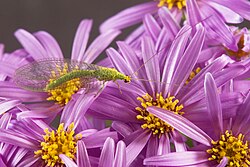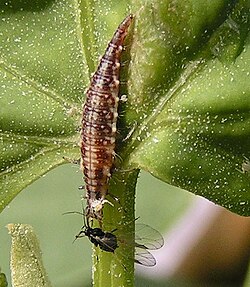Lacewing
Lacewings, or 'Green lacewings', are insects in the large family Chrysopidae of the order Neuroptera. There are about 85 genera and (differing between sources) 1,300–2,000 species in this widespread group. However, in America and Europe, the two genera Chrysopa and Chrysoperla are very common.[1]
| Lacewings | |
|---|---|

| |
| Pseudomallada edwardsi | |
| Scientific classification | |
| Kingdom: | |
| Phylum: | |
| Class: | |
| Order: | |
| Suborder: | |
| Superfamily: | |
| Family: | Chrysopidae
|


Most species of lacewings and their larvae are active predators, and are often used for biological control.[2]
Many adults of Chrysopa can defend themselves by giving out a vile smell from glands at the front of their thorax.[3]
They have 'ears' at the base of their front wings. When they hear bat echolocation sounds, they close their wings and drop down. They can escape spider webs, because, being so light, they do not create much vibration to alert the spider. Instead of struggling like most insects, the lacewing bites through the strands holding its legs and antennae. When it is stuck only by its wings, it become completely immobile. Slowly, the lacewing slides downwards out of the web. Tiny hairs on the wings prevent the sticky spider silk from touching the wings' surface.[3]
The larvae are voracious, attacking other insects of suitable size, especially soft-bodied ones (aphids, caterpillars and other insect larvae, insect eggs). When they touch a potential prey object, the larva grasps it. Their maxillae[4] are hollow, and inject a digestive secretion into the prey. The organs of an aphid can be dissolved by this in 90 seconds.
References
change- ↑ Engel, Michael S. & Grimaldi, David A. 2007. The neuropterid fauna of Dominican and Mexican amber (Neuropterida, Megaloptera, Neuroptera). American Museum Novitates 3587: 1–58. PDF fulltext Archived 2008-12-17 at the Wayback Machine
- ↑ New T.R. 2002. Prospects for extending the use of Australian lacewings in biological control. Acta Zoologica Academiae Scientiarum Hungaricae 48(Supplement 2): 209–216. PDF fulltext
- ↑ 3.0 3.1 Eisner, Thomas & Maria and Siegler, Melody 2005. Secret weapons: defenses of insects, spiders, scorpions, and other many-legged creatures. Harvard University, Belknap Press.
- ↑ Appendages either side of the mouth.